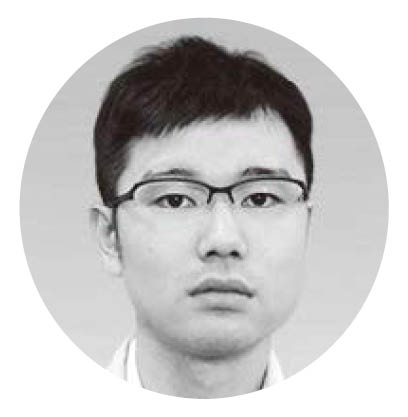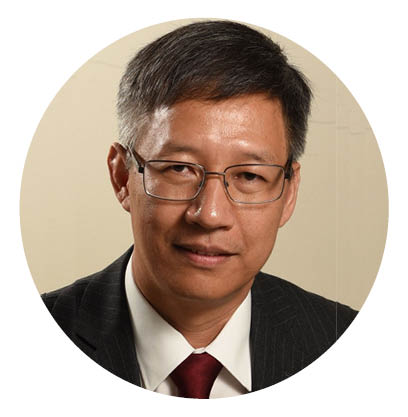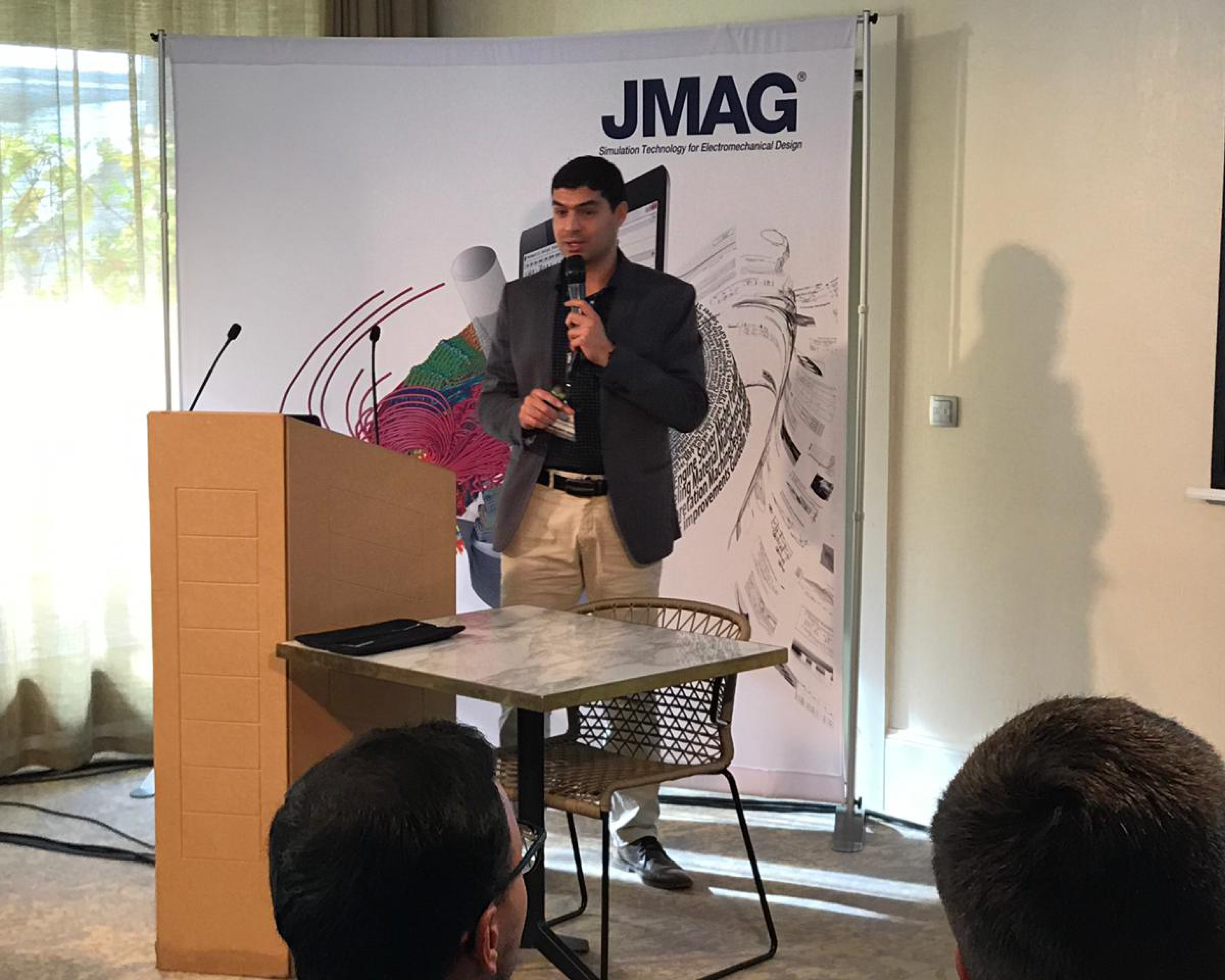Introduction
On October 15th 2019, Powersys organizes the 9th European JMAG user
conference. This FREE event will take place in Strasbourg at
the SOFITEL STRASBOURG GRANDE ILE.
The User Conference will be followed by a 2-day workshop session on October 16th and 17th at the same place.
Why attending

Discuss with JMAG users, share your experience and exchange with JMAG developers.

Discover JMAG upcoming developments and express your software development needs.

Discover JMAG user case study presentations providing insigths and real-world experiences.
AGENDA
FREE USER CONFERENCE
-
October 15th
USER CONFERENCE
-
- 9.00 am: Welcome breakfast / Attendee registration
- 9.30 am: Introduction | Powersys
- 9.45 am: Development planning of JMAG | Dr Takashi Yamada, JSOL Corporation
JMAG is constantly being worked on to achieve highly accurate and high-speed simulation. JSOL would like to share our progress from the past year including parallel solvers to accelerate speed as well as GUI improvements aiming for increased productivity of analysis workflow. Analysis technologies we are currently focusing on and our plans for incorporation will also be covered in this presentation. Design exploration is an important topic this year. This presentation will detail the present and future of JMAG. - 10.30 am: High power electric machine design with JMAG | Aymen Ammar, Jeumont Electric
 JEUMONT Electric is a manufacturer of high power electrical rotating machines. In order to respond quickly to customers requirement JEUMONT Electric developed many tools based on analytical models. However, for specific requirements or to study local phenomena the use of Finite Elements Methods is unavoidable. First we will see how we used JMAG to solve noise issues of an asynchronous motor. Secondly, we will present an optimization of a salient poles synchronous generator. Finally, we will explain how we used JMAG to optimize a 3.6MW Direct-Drive Superconducting Wind Turbine Generator.
JEUMONT Electric is a manufacturer of high power electrical rotating machines. In order to respond quickly to customers requirement JEUMONT Electric developed many tools based on analytical models. However, for specific requirements or to study local phenomena the use of Finite Elements Methods is unavoidable. First we will see how we used JMAG to solve noise issues of an asynchronous motor. Secondly, we will present an optimization of a salient poles synchronous generator. Finally, we will explain how we used JMAG to optimize a 3.6MW Direct-Drive Superconducting Wind Turbine Generator. - 11.00 am: Coffee break
- 11.30 am: Accounting for AC loss in the electric machine design process using JMAG | Dave Winterborne, Höganäs AB research associate based at Newcastle University
 Accounting for AC loss in the electric machine design process using JMAG In the case of electric machines operating at higher fundamental frequencies, additional losses due to skin and proximity losses - particularly in open slot designs - are significant and must be considered in the electromagnetic and thermal design of the machine. How can we use JMAG to incorporate this into an existing design methodology for SMC-based axial flux machines and produce accurate results without excessive computational cost?
Accounting for AC loss in the electric machine design process using JMAG In the case of electric machines operating at higher fundamental frequencies, additional losses due to skin and proximity losses - particularly in open slot designs - are significant and must be considered in the electromagnetic and thermal design of the machine. How can we use JMAG to incorporate this into an existing design methodology for SMC-based axial flux machines and produce accurate results without excessive computational cost? - 12.00 pm: Load Influence on AC Resistance of a High-Speed Permanent Magnet Electric Machine for Electric Vehicle Applications | Dr Ziwei Li, AVL Germany
 AC copper losses become increasingly important in electric machine design, especially for high speed applications. AC copper losses can be influenced by many factors, such as the operation frequency, load angle, temperature and winding types and arrangement. A case study of machine design including AC copper losses is presented which has taken into account all the aforementioned factors. The results of efficiency and thermal conditions of the machine will be the main focus. The way how we use JMAG to setup AC copper losses will also be shown, such as script operation and the winding function.
AC copper losses become increasingly important in electric machine design, especially for high speed applications. AC copper losses can be influenced by many factors, such as the operation frequency, load angle, temperature and winding types and arrangement. A case study of machine design including AC copper losses is presented which has taken into account all the aforementioned factors. The results of efficiency and thermal conditions of the machine will be the main focus. The way how we use JMAG to setup AC copper losses will also be shown, such as script operation and the winding function. - 12.30 pm: The cutting influence on magnetic laminates and its consideration in JMAG for electric traction motors | Mathias Lindner, IAV GmbH
 The degradation of soft magnetic properties due to cutting of electrical steel sheets is a well-known effect and has been demonstrated in numerous studies. However, most findings are hardly applicable in the calculation of electrical machines because of complex geometries, unaddressed impacts on the magnetization curve as well as a lack of data due to strong dependencies on the material and the manufacturing method. For this work a feasible approach was used, based on standardized tests of soft magnetic properties in ring specimen, to identify the material characteristics depending on the cutting edge distance. These magnetization and loss curves have then be applied to JMAG layer models of simple test geometries as well as electrical traction drives. Measurements finally proof the capability of such an approach to predict the magnetic behaviour under cutting influence.
The degradation of soft magnetic properties due to cutting of electrical steel sheets is a well-known effect and has been demonstrated in numerous studies. However, most findings are hardly applicable in the calculation of electrical machines because of complex geometries, unaddressed impacts on the magnetization curve as well as a lack of data due to strong dependencies on the material and the manufacturing method. For this work a feasible approach was used, based on standardized tests of soft magnetic properties in ring specimen, to identify the material characteristics depending on the cutting edge distance. These magnetization and loss curves have then be applied to JMAG layer models of simple test geometries as well as electrical traction drives. Measurements finally proof the capability of such an approach to predict the magnetic behaviour under cutting influence. - 1.00 pm: Lunch
- 2.30 pm: Development and simulation of multiphase machines with JMAG | Daniel Keller, DAIMLER AG
The electrification of the electric powertrain of upper-range sedans and SUVs are linked with steadily increasing power demands. Because of limitations in the power electronics, in particular the IGBT module limits the maximum current, new electric motor designs are necessary. One possibility to achieve a higher torque and power density is to split up the parallel path of a conventional three-phase winding into two equal halves and increase therefor the number of phase belts. This offers the possibility to choose a phase-shift between the resulting winding sets. A common used machine type is the dual three-phase machine with two winding sets and isolated star points. There are different possibilities for the winding design, e.g. designing the winding with an electrical phase shift of 30° decreases the torque pulsation but causes in certain circumstances additional current harmonics. This presentation shows a simulation workflow for dual three-phase machines with different phase shifts for automotive traction drive applications. The author proposes to couple the FEA analysis with the current controller to get a more realistic model, especially for multiphase machines where current harmonics are expected. - 3.00 pm: 3-D design of transverse flux machine | Rajesh Kumar, Sheffield University
The higher specific torque and power density of a transverse flux permanent magnet (TFPM) machine in comparison to a conventional machine makes it a promising candidate for direct drive applications. This presentation includes comprehensive analysis of single sided surface mounted TFPM machine. The complicated structure of TFPM machine requires 3-D finite element method for its analysis. Therefore, these 3-D FEM are carried out through JMAG designer v. 18.1. Initially, one pair of single phase TFPM needs to be modelled separately taking benefit of special structure and periodicity. Then, the performance of single phase and 3 phase model is compared under open and close circuit condition. Finally, 3-D optimization is carried using Genetic Algorithm. - 3.30 pm: Development of Thin and High Torque Axial Gap Motor Using Soft Magnetic Powder Cores | Tatsuya Saito, Sumitomo Electric Industries, Ltd.
 Currently, radial motors using laminated steel sheets are the mainstream for motors, but the needs for automotive applications, miniaturization and higher output are increasing. For these trends, we have demonstrated that axial gap motors with soft magnetic powder cores are effective for thinning and high power output for radial motors of the same size. In this presentation we will introduce the latest situation of the development of softmagnetic powder core contributing to high performance of various motors including the above-mentioned motors and examples of application to motors.
Currently, radial motors using laminated steel sheets are the mainstream for motors, but the needs for automotive applications, miniaturization and higher output are increasing. For these trends, we have demonstrated that axial gap motors with soft magnetic powder cores are effective for thinning and high power output for radial motors of the same size. In this presentation we will introduce the latest situation of the development of softmagnetic powder core contributing to high performance of various motors including the above-mentioned motors and examples of application to motors. - 4.00 pm: Coffee break
- 4.30 pm: Demagnetization study of permanent magnets in electric motors using a 2D finite element modeling in JMAG | Moustafa Al Eit, Nidec PSA E-Motors
 Nidec PSA emotors is a joint venture created, by Nidec Leroy-Somer and the PSA Groupe, to supply high-performance and competitive electric traction motors for electrified vehicles. For reasons of performance and durability, the demagnetization problem of permanent magnets is crucial. In fact, demagnetization phenomena leads to an irreversible degradation of the remanent flux density of permanent magnets; and when this occurs, it is highly depending on the rotor temperatures and the supply currents of the operating range. Furthermore, taking into account possible defects in the electric circuit is necessary to have a comprehensive complete study. Now, to analyze such electromagnetic phenomena in order to determine our specifications on the grad of the permanent magnets we perform using the JMAG software, a 2D finite element modeling of the electric motors coupled with the appropriate electric circuit.
Nidec PSA emotors is a joint venture created, by Nidec Leroy-Somer and the PSA Groupe, to supply high-performance and competitive electric traction motors for electrified vehicles. For reasons of performance and durability, the demagnetization problem of permanent magnets is crucial. In fact, demagnetization phenomena leads to an irreversible degradation of the remanent flux density of permanent magnets; and when this occurs, it is highly depending on the rotor temperatures and the supply currents of the operating range. Furthermore, taking into account possible defects in the electric circuit is necessary to have a comprehensive complete study. Now, to analyze such electromagnetic phenomena in order to determine our specifications on the grad of the permanent magnets we perform using the JMAG software, a 2D finite element modeling of the electric motors coupled with the appropriate electric circuit. - 5.00 pm: JMAG suite use within electrical machine development process | Mamy Rakotovao, Valeo
 Multiphysics and multi-domain approach is key when developing a new range of electrical machine. With JMAG software, we are now able to take into account in an accurate manner the most of critical development aspects when dealing with pre-design of the electrical machine, system integration, thermal constraints and noise issue. This is possible because this kind of software allows accurate losses and magnetic forces computation by handling very realistic electrical machine operation in various conditions such as actual control techniques, thermal impact on material characteristics and, of course, real machine drawing.
Multiphysics and multi-domain approach is key when developing a new range of electrical machine. With JMAG software, we are now able to take into account in an accurate manner the most of critical development aspects when dealing with pre-design of the electrical machine, system integration, thermal constraints and noise issue. This is possible because this kind of software allows accurate losses and magnetic forces computation by handling very realistic electrical machine operation in various conditions such as actual control techniques, thermal impact on material characteristics and, of course, real machine drawing. - 5.30 pm: Cocktail & One-to-one meetings
- 9.00 am: Welcome breakfast / Attendee registration
WORKSHOP
from 1600€ to 2300€-
October 16th
MACHINE DESIGN THEORY: LECTURES by Pr. Tim Miller & Pr. Zhu
-
- 9 am - 12 pm Principles of AC Machine Design, with Examples | Professor Tim Miller
The objective is to learn the straightforward principles of AC machine theory and to design three motors following classical methods of synthesis. The starting point is an induction (asynchronous) motor, which we will convert first to an interior PM motor, and secondly to a synchronous reluctance motor. By this means we will understand the differences between these machine types, and where these differences come from.
Contents:
1. Configuration and characteristics; classification, saliency, pole-number; sine-distribution of field and ampere-conductors
2. Design example: specification
3. Sizing; details of geometry and dimensions; magnetic and electric loading; current-density; rating
4. Winding layout, including fundamental theory of winding factors
5. Induction motor: design using conventional method of synthesis and equivalent circuit
6. Brushless PM Motor: convert the induction-motor rotor to a PM rotor
7. Synchronous reluctance motor: remove the magnets and create a pure reluctance motor
8. Comparison of the three example motor designs
9. Discussion of control characteristics and requirements
We don’t use any software in this short course, but most of the design examples can easily be repeated using JMAG Express. The examples are ready for further analysis using JMAG Designer, and some examples of finite-element calculations are included, giving additional insight into the designs. - 12.00 - 1.30 pm: Lunch
- 1.30 - 5 pm Electrical Machine Technologies, Topologies, and Applications | Professor ZQ Zhu, University of Sheffield, UK
This presentation will start with the stator and rotor topologies of permanent magnet machines, with a focus on fractional slot machines. Then, the electromagnetic performance of alternate electrical machine technologies, i.e. induction machines, synchronous reluctance machines, and permanent magnet synchronous machines, will be compared for electric vehicle application. Recent development will be highlighted, including magnetic gears, magnetically geared machines, novel fractional slot and Vernier permanent magnet machines. The presentation will end with analysis, reduction and utilization of cogging torque in permanent magnet machines.
Contents:
1. Stator and rotor topologies of permanent magnet machines
2. Fractional slot permanent magnet machines
3. Electrical machines technologies and application for electric vehicles
4. Recent developments: magnetic gears, magnetically geared machines, fractional slot machines and Vernier permanent magnet machines
5. Cogging torque: analysis, reduction and utilization - 5.00 - 5.30 pm Reminder about the Theoretical session of last year User Conference Workshop about Iron Loss calculations in JMAG | Yves Thioliere, Powersys
- 9 am - 12 pm Principles of AC Machine Design, with Examples | Professor Tim Miller
In the morning session, we will focus on specific and new features of the JMAG V18. The procedure, all settings, advantages and limitations will be deeply detailed. Each feature will be illustrated by a simple exercise based directly on the topic of the feature.
In the afternoon, we will conduct 2 model sets up from scratch and based on several features which has been reviewed in the morning. Those exercises will be similar to real-life model set up starting from the shape edition and ending by the result display.
-
October 17th
PRACTISE DAY: HANDS-ON TRAINING by JMAG experts
The attendees will handle JMAG and a temporary license will be provided. No computer will be provided. Demos and exercise will be given during this training session.
-
- 8.15 am: Circuit control | Didier Zefack, Powersys
- 9.15 am: New winding editor | Ahmed Shoeb, Powersys
- 10.15 am: Coffee break
- 10.30 am: Efficiency map | Yves Thiolière, Powersys
- 11.30 am: Topology optimisation | Ahmed Shoeb, Powersys
- 12.30 pm: Lunch
- 1.45 pm: Setting an analysis from scratch for a (topology) optimization | Didier Zefack, Powersys
- 2.45 pm: Coffee break
- 3.00 pm: Setting an analysis from scratch for a parametric efficiency map generation | Yves Thiolière, Powersys
- 4.00 pm: End of the workshop
- 8.15 am: Circuit control | Didier Zefack, Powersys
VENUE
SOFITEL STRASBOURG GRANDE ILE
4 Place Saint-Pierre-Le-Jeune
67000 STRASBOURG
FRANCE
SPEAKERS

Moustafa Al Eit
Moustafa Al Eit was born in Baalbeck, Lebanon in 1990. He received the graduate degree in electrical engineering from the faculty of engineering at the Lebanese university, Beirut, Lebanon in 2013. He received a master’s degree in Physics and engineering in the electrical energy from the École Superieure d’Électricité (SUPELEC), Gif-sur-Yvette, France in 2013. In 2016, he received the Ph. D. degree in Physics for electrical engineering applications from the University of Paris-Saclay, Orsay, France. From October 2016 to May 2018, he was a post-doctoral researcher at the laboratory L2EP in the École Nationale Supérieure d’Arts et Métiers (ENSAM), Lille, France. Since June 2018, he occupied an electrical engineer position with a specialty on the motor design for electric vehicles at the joint-venture Nidec PSA emotors.

Aymen Ammar
Aymen Ammar obtained a degree in electrical engineering from National Engineering School of Tunis. He got a M.S and a Ph.D degrees in 2009 and 2013 from Ecole Centrale de Lille. He is currently an electric rotating machines designer at JEUMONT Electric.

Daniel Keller
Daniel Keller studied Engineering Cybernetics and received his M.Sc. degree in July 2017 from the University of Stuttgart. Since November 2017, he is working in the Advanced Engineering Department for electrical drives at Daimler AG in Stuttgart. He is also a doctoral candidate at the Institute of Electrical Energy Conversion at the University of Stuttgart. His focus lies in the modelling, control and optimization of high power density permanent magnet synchronous machines, especially multiphase machines.
PICTURES
This event is organized by Powersys, JMAG distributor in Europe. For any questions, please contact us at marketing@powersys.fr.



















